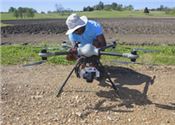|
Know Misconceptions Of Unmanned Aircraft

David Young, a flight coordinator with the Geosystems Research Institute at
Mississippi State University, prepares an unmanned aircraft to fly over test plots
at the H. H. Leveck Animal Research Center April 7, 2016.
Photo by MSU Extension/Kevin Hudson
STARKVILLE, MISS.
Part of understanding any emerging technology is clearing up common misunderstandings about it.
About a year ago, the Mississippi State University Extension Service began developing a new program known as Unmanned Aircraft Systems for Decision Agriculture and Environmental Management. The program is designed to educate anyone who might use unmanned aircraft systems, or UAS, professionally or recreationally.
Louis Wasson, a senior Extension associate with the MSU Geosystems Research Institute, or GRI, said this technology has tremendous potential in a wide variety of areas, including agriculture, construction, utilities, and search and rescue. Anyone interested in the technology must know the basic Federal Aviation Administration regulations for remotely controlled aircraft, or drones.
“Our airspace is big, congested and complicated,” Wasson said. “FAA regulations have kept it safe, but when you add something to that airspace with the potential these systems have, that safety can be compromised quickly.”
The FAA issued its final rule on commercial UAS use last month, but previously existing rules are only now becoming more understood by the general public. Wasson said there are many misconceptions regarding the use of UAS.
Misconception No. 1: They are new technology
While general interest in UAS has grown mostly in the last three years, the FAA has regulated their use since the 1970s, and the U.S. military has used them since the 1960s.
“We are now getting to the point where general public awareness about UAS capabilities is necessary because they’ve gotten smaller and easier to fly, so people are going to see more of them,” Wasson said. “Remote-control planes and helicopters have been around for many decades and flown by hobbyists for fun on the weekend. What has changed dramatically is the miniaturization of sensor technology and high-level artificial intelligence that are now flying on these small unmanned systems.”
Misconception No. 2: They can legally be flown anywhere.
Safety and privacy are two main concerns often associated with the growing popularity of UAS technology. Like any aircraft, the systems can fail and cause injury. Like any technology, they can be used for the wrong reasons.
“Thousands of people got a UAS this past Christmas, and many thought they could just go out and fly the aircraft anywhere. This is not the case,” Wasson said. “On roads, we have the yellow stripe that keeps us on the correct side of the road. In airspace, altitude is that yellow stripe.
“Manned airplanes fly at no less than 500 feet except during takeoffs and landings. UAS aircraft cannot be flown above 400 feet, so we have a 100-foot altitude buffer between manned and unmanned aircraft,” Wasson added.
David Young, GRI flight coordinator, said operators cannot fly within 5 miles of an airport unless they get permission from the airport or airport tower.
“Any UAS must weigh less than 55 pounds and remain in line of sight of its operator,” Young said. “For that reason, unmanned aircraft also cannot be flown at night.”
Wasson said UAS technology has evolved so much that nearly all the machines can fly themselves.
“Flying into a neighborhood is easy, and with the resolution on some UAS cameras, you could almost figure out what book someone is reading,” he said. “If you see a low-flying UAS over your backyard, that’s intrusive. So if you’re going to fly that ‘toy’ you got at Christmas, go to an open field away from airports and neighborhoods.”
FAA guidelines also disallow flying over sensitive infrastructure, such as power stations, water treatment plants and heavily traveled highways.
Misconception No. 3: Hobbyists do not have to register their aircraft.
Beginning in December 2015, the FAA mandated registration for all owners of small, unmanned aircraft that weigh more than half a pound. Last month’s new FAA regulations mandate that anyone flying a UAS must be at least 16 years old. Operators must also have a remote pilot certificate with a small UAS rating from the FAA, or they must be directly supervised by someone with certification.
“If you go to a store and purchase a UAS or buy one online, it has to be documented,” Wasson said. “The FAA wants to know who is flying. If an enforcement official asks to see registration of your aircraft, you’re breaking the law if you don’t have it, and you pay a fine up to $27,500 and have your UAS confiscated if you’re being dangerous.”
Registering a recreational UAS can be done online at http://knowbeforeyoufly.org/register-your-drone/.
Misconception No. 4: They are toy planes.
Small drones are more than just model airplanes because of their cameras and the fact that they can perform other functions than just moving around by remote control.
The Geosystems Research Institute routinely uses unmanned aircraft in precision-agriculture applications. GRI researchers fly them over MSU research plots to collect data and photos, which they later analyze.
As the leading university of the Alliance for System Safety of UAS through Research Excellence (ASSURE), MSU provides research findings to the FAA to help the market for unmanned aircraft grow into its potential.
For more information on UAS operations and FAA regulations, visit http://extension.msstate.edu/agriculture/precision-agriculture/types-uas. Learn more about ASSURE at http://assureuas.org. ∆
|
|